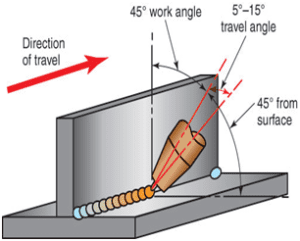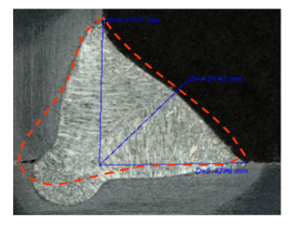
Manesh M. Khatri
Director
Sparkline Welders

Varun M. Khatri
Head, Simulator Division
Sparkline Welders
Bridging the welding skills gap in the manufacturing industry
Abstract
This skills gap, or disparity between the skills job-seekers have and the skills employers need, can be seen in industries across the nation. The crux of this paper is to understand what factors are contributing and intensifying the manufacturing skills gap, and how can the industry bridge this gap.
Fabrication industry isfacing heaps of problems associatedwith welding training and quality welding, here through this paper I would like to answer and revolutionize the welding training. Immersive Technologies like Virtual reality, Mixed Reality play a vital role in training and building the welding skills gap. This study outlines the trends and the importance of skill development and therefore the approach in the skill sector. We tend to study how parameters like welding speed, travel angle, arc length are monitored using welding simulators and the way it edges a first time welder.
Keywords: Welding training, Skill development, Virtual Reality, Welding Simulators, Augmented Reality, Manufacturing and fabrication industry.
Introduction
American Welding Society President David McQuaid quotes “Welding is an essential part of everyday life. From cars to high rise office buildings, airplanes to rockets, pipelines to highways, none of it would be possible without welding.” Welding is the key technology for the fabrication and assembly of metal structures. In some industries, most notably automotive, welding is completed primarily by robots or automated machinery. In many industries like shipbuilding, heavy equipment production, and small scale part-fabrication, welding could be a value-added operation that’s largely a manual process applied by humans. Training of new welders is a significant activity both for industry as well as for the vocational training community. Training is particularly important for welders performing on critical items like pressure vessels, nuclear piping, and naval ships, where welds have top quality requirements and are carefully inspected. However, the trade lives fast changes, and it has to adapt to new generations. Along with the skill gap, there is also an age gap among the welders that is affecting the growth of the manufacturing industry. These experienced workers are close to their retirement, and the problem is growing with the lack of incoming skilled welders. The paramount concern is to draw in the new generation for welding training. The trade must be appealing to newcomers, and therefore the need for skilled welders can and will be a motivation call for people searching for a career as welder. So, what should be the future move within the welding skill development and training?
Immersive technology refers to technology that attempts to emulate a physical world through the means of a digital or simulated world by creating a surrounding sensory feeling, thereby creating a sense of immersion Immersive training includes, Virtual Reality, Augmented Reality, Mixed Reality[1]. Immersive Technology used to be something you’d experience/see in Sci-Fi books or watch in Sci-Fi movies. Today, Immersive Technology has many various applications and can be utilized by brands and consumers alike in countless ways. Virtual reality (VR) is currently used as a training tool in a number of different application areas including medicine, aviation, law enforcement, and the military. For example, VR simulations with haptic are routinely used for training surgeons in laparoscopic techniques and commercial pilots train almost exclusively on flight simulator platforms. Virtual technology is a good way to introduce people to welding training and to induce students up and running with the fundamentals of certain processes. VR technology training is capable of improving the effectiveness of welder training. This study used a virtual reality welding simulator, WELDBOTT, to explain the trends and the importance of skill development and therefore the approach in the skill sector to improve the welding training. We tend to study how parameters like welding speed, travel angle, arc length are monitored using welding simulators and the way it edges a first time welder. VR welding simulators are also making its way to the welding classrooms, and it’s proving to be a vital tool for modern welding training.
Literature Survey
A skills gap is the difference between the talents required to perform a specified job, and the actual skills that employees possess. When a corporation or industry says they are stricken by a skills gap, this implies that they are experiencing difficulties finding workers to hire who have the abilities to perform the required task. Today’s metal fabricating companies face an unusual challenge: within the event that they receive an out-sized number of employment applications for an open position, only a little number of applicants truly are qualified to try and do the desired skilled labor. This adds to the complexity of hiring qualified workers from a shrinking skilled-labor pool.
Case Study 1:
Virtual Welding Training Simulators as an Assessment Tool
When it involves the hiring process, applicants easily can say on paper that they possess the key skills outlined within the job description. [2]Typically, it’s not until after the HR department and hiring managers sit to complete a full review, including employment screening, safety training, and a hands-on welding test, that they will fully know if applicants are able to do practical welding and ready to go on site. By now, an experienced company employee, who likely proctored the test and assisted with training, already has spent numerous hours faraway from production, and therefore the company has spent money on raw materials and consumables, as an assessment test, for nothing productive.
Vermeer Corp., a Iow-based manufacturer of agriculture, construction, surface mining, organic recycling, and wood waste processing equipment, believe virtual welding training technology solves that hiring problem. In 2011, the firm received a welder workforce development grant from American Welding Society (AWS) to undergo a newly designed welding training program that integrated virtual reality welding in the traditional welding training practise. The firm soon realized that the virtual welding tool not only could function as a wonderful companion to hands-on welding training, but also as an efficient screening tool. It became easier for the HR Department to weed out the lower skilled welders, without wasting any raw materials.
Based on the results from the welding simulator results, the firm would finalize the candidates selection. Once the small pool of qualified welders have been gleaned through the virtual welding screening process, the hiring managers would call the expert welder of the organization for hands on test. This model became a success and later in 2012 in launched this process at Vermeer Beijing Manufacturing Ltd., a Chinese subsidiary.
Case Study 2:
Once the welder has been recruited, there’s a need for training at the fabrication site-a process that the manufactures are taking it into their own hands. Some programs do integrate this with the virtual reality training module. It was noted that the workers who moved directly into the fabrication shop without virtual training took more time to adapt and learn welding. Therefore, to expedite the process, more and more firms are incorporating virtual training module. This also gives them an advantage of cost cutting in the training. Today’s Trinity’s US and Mexico fabrication plants uses virtual reality welding training simulator to make the goal a reality. Virtual Reality WELDBOTT aligns with the companies precise welding jobs, customization of work-piece, for better efficiency in the welding training.
The Problem Statement
The AWS estimates the US will face a shortage of 400.000 skilled welders by 2024, in an industry valued at over $5.5 billion, the problem is real, and given the traversal role of the trade, it’ll grow even bigger. The lack of skilled welders is beginning to have its effects on different industries, in 2018 both Fiat and Ford experienced trouble with their cars thanks to welding issues. Fiat had to recall 18000 Jeep Wranglers due to a faulty weld within the frame of the vehicle. The defective pump welds in a number of their vehicles forced another automotive giant, Ford, to recall 12,000 vehicles in North America. These sorts of welding issues are having an impression on other industries, the United Kingdom had to delay their new £31 billion nuclear missiles when it had been discovered that the missile tube had cracks.
Immersive Technology and its Application
Virtual Reality isn’t a new concept. The origins of virtual reality can be traced as far back as ‘The Ultimate Display’, a seminal paper published by Ivan Sunderland, he introduced the key concept of immersion in a simulated world, and of the complete sensory input and output, which are the footings of the present world virtual reality research. [3] The challenge was set:
The screen could be a window through which one sees a virtual world. The challenge is to create that world look real, act real, sound real, feel real.
Sunderland’s challenge is explained as offering presence simulation to users as an interface metaphor to a synthesized world has become the research agenda for a growing community of researchers and industries. The motivation for such an exploration is twofold. From an evolutionary perspective, VR is seen as some way to beat limitations of ordinary human-computer interfaces; from a revolutionary perspective, VR technology opens the door to new sorts of applications that exploit the chances offered by presence simulation. A human-computer interface, a desktop metaphor is well suited for interaction with the 2D world. This limitation is overcome by VR. VR is more than just interfacing, It enables interaction with the 3D worlds. This technology, therefore, makes nearly every area of human activity a candidate for a VR application. [4]
Virtual Prototyping
Decisions taken during the planning phase of enormous scale engineering projects are often the foremost delicate ones, owing to their possibly dramatic effect on final results, timings, and costs. Mock-ups are routinely used for applications like testing equipment integration, accessibility and space requirements in domains starting from aerospace and automotive manufacturing to architecture. Virtual prototyping allows designers to check and correct their design as when using physical mock-ups, to make it even better, earlier and with more opportunities for multi-site collaborations. Architectural building walk-thru has been one among the most successful applications of VR.. These systems, the best examples of virtual prototypes, permit the architect to prototype a building and to iterate along with his client on the detailed desiderata for it.
Examples include the ISS VR Demonstrator utilized by Rolls-Royce to create an assessment of how easy it might be to make an engine and maintain it and Boeing’s high-performance engineering visualization system used during the draft of the 777. Also, the French Space Agency, CNECS, and CISI collaborated to launch the PROVIS research project in 1995 for developing solutions for satellite and space equipment designers, to build, manipulate and examine their models using digital, 3-dimenstional, interacting mock-ups. CERN and CRS4 have jointly developed the i3D system using virtual prototyping. These efforts demonstrate the interests of interactive virtual prototyping for early design stages.
Simulators and Training
One of the foremost important characteristics of VR is that the user can exploit existing cognitive and motor skills for interacting with the world in a range of sensory modules, haptic and, in many instances, the experience gained within the virtual environment is directly transferable to the real world. This aspect has been put to profit for a spread of simulators and training systems. Many research and industrial applications exist, in diverse domains like flight simulation, driving simulation and surgical simulation.
Augmented Reality
In augmented reality systems, the virtual world is superimposed over the real world, with the intent to supplement it with useful information, for instance, guidance in performing a real-world task. Recently the capabilities of real-time video image processing, computer graphic systems, and new display technologies have transformed to create the display of a virtual graphical image correctly registered with a view of the 3-Dimensional environment surrounding the user possible.
Revolutionizing Welding Training
An emerging method of assessment within several industries is the immersion of the person into a virtual reality (VR) simulation. Since the conception of VR welding simulations, many strides are made to reinforce the VR experience. One major stride has been creating the foremost realistic weld pool. The realistic 3D weld pool alongside the creation of human welder response models have led to several other advancements in robotic welding and welding training through the years. Human welder response models were created by observing the reactions of a welder to the looks of the weld pool during a welding process. Understanding how a welder reacts to the weld pool may cause why novice welders perform at a lower level than advanced welders. This paper uses WELDBOTT for explaining the concepts of welding and virtual reality welding training.
Enhancements in welding training have stemmed from the creation of neuro-fuzzy logic for robotic welding machines. From this advancement, visual feedback devices have been created for virtual reality trainers to help novice welders correct themselves. Another feedback system that has been created incorporates vibration sensors on the welding helmet to give feedback to novice welders. This method has been found to be easier to integrate into a training program than the visual feedback system. From these feedback devices came virtual reality welding simulation trainers that fully immerse a student into a virtual reality environment. Some of the virtual reality welding simulators are ARC+, the Fronius virtual welding system, and VRTEX® 360. Industries have used VR simulations to allow trainees to learn basic skills in a safer environment.
Virtual reality (VR) environments are often accustomed train workers to accumulate the fundamental skills to perform the tasks required for employment in a technical field. However, performance in a VR environment might be used as an indicator to hire a personnel. Training within a VR environment can prepare a trainee to anticipate and recognize when situations go awry, furthermore as a test an individual’s decision-making skills under normal and stressful conditions. Such evaluation is feasible through dynamic and continuously changing VR environments. Training in such environments can result in increased memory retention, reduced human error, and a deeper understanding of the complexities of a work environment. Evaluating critical thinking skills is additionally possible by evaluating how a person adapts to changing conditions within a VR environment. The requirements for virtual reality applications are defined by analyzing the needs in terms of input and output channels for the virtual world simulator.
Welding Parameters monitored by Simulator.
The input channels of a VR application are those with which humans emit information and interact with the environment. We interact with the real world mainly through locomotion and manipulation, and that we communicate information mostly by means of voice, gestures, and facial expressions. Gestural communication, additionally as locomotion, make full-body motion analysis desirable, while verbal communication with the computer or other users make voice input a crucial option
In welding we consider hand moment of the welder as an input. To be specific, these inputs include
- Welding Speed: The speed at which the welder performs the welding. Depending on his hand movement the sensors on the welding torch take the feedback and form the weld pool.
Travel Angle: The travel angle is defined as angle relative to the gun in a perpendicular position. Normal welding conditions in all positions involve a travel angle of 5 to 15 degrees. Travel angles beyond 20 to 25 degrees can cause more spatter, less penetration and general arc instability

- Work angle: Work angle is the angle from the horizontal measured at right angles to the direction of welding. Travel angle is the angle in the direction of welding and may vary from 5 to 30 degrees, depending on the welder’s choice and conditions
- Arc Length:The arc length, also called arc gap, is the distance between the part that has to be welded and the electrode tip. The arc length depends on the arc stability, the weld current and the concentricity of the part.
These are the main parameters that are evaluated by the Virtual Welding Simulator, otherwise, in traditional training is not possible.
Thus, a novice welder understands the deep rooted flaws at an early stage of learning. The existing welder can also work on these parameter and improve his/her skills.
The simulator also provides welding parameters as representing of highest fidelity model for welding. Selection of Welding current, voltage, Gas speed, Wire feed rate etc.

Fig. 3: Cut section view of T-joint of WELDBOTT.

Fig. 4: Real Destructive Testing analysis of welding in T joint.

Fig. 2: Cut section view on WELDBOTT.
Sound Feedback
Some of these systems can generate multiple sounds at a time, possibly 2-D and 3-D together. Other interesting features are: Doppler shifts simulation with the sounds changing while travelling past the listener, control of reverb reflection, possibility to perform an acoustic ray-tracing of rooms and environments. Depending upon the chosen systems, the sounds are delivered to the user by speakers or earphones.
Sound of welding during SMAW, GMAW, and GTAW vary with different changes in welding parameters. This simulation brings the welder the exact feel of welding. It trains his sensory neurons for the same type of welding bead formation in real world.
Sensory Feedback
Our sense of physical reality is a construction derived from the symbolic, geometric, and dynamic information directly presented to. The output channels of a virtual reality application correspond thus to our senses: vision, touch and force perception, hearing, smell, taste. Sensory simulation is thus at the heart of virtual reality technology.
Vibration feedback from the welding torch during welding is a touch sensory feedback.
At the current time, a decent choice of economic products exists for visual, tracking, and user input interfaces. Auditory and haptic interface technologies currently are almost restricted to research applications but are getting ready to be used in practical applications. Full-body motion interfaces are limited to specialized entertainment systems, support for more general sorts of movement still is exclusively an exploration topic. The olfactory interface is the least mature of all the technologies. Even the foremost mature technologies (visual and tracking) still suffer from some limitations, and in no instance, VR interface technology perfectly matches human sensory capabilities. It is important to notice, however, that it now possible, as against the case of only a couple of years ago, to own devices that provide fairly good quality and are usable for several, if not all, applications. As full fidelity of sensory cues isn’t achievable even with the foremost advanced and expensive devices, It is thus of primary importance when developing a VR application, to carefully study the precise fidelity required and therefore the most appropriate devices and trade-offs needed for satisfying those requirements at the best .
Futuristic Approach
The technology goes through a renaissance, with smart phone companies, computer game developers, and even movie studios looking into ways to use virtual simulations. Although VR technology has been around for years, advancements in sound, video, and input technology have moved the tool well beyond the clunky, expensive, and extremely-limited VR that fizzled in past decades. Currently, VR technology is additionally making its way into the welding classroom, and it’s proving to be a significant tool for the trendy welder. [6]
More practice without the added costs.
Good welding takes practice. To master a welding technique, each student requires hours of practical experience. Meaning most students are using filler metal, gas, and other consumables that increase training costs. This, in turn, restricts the time that welding programs on limited budgets can allow their students to practice. With virtual welding, schools can allow their students to practice freely without concern about material costs. The advantage of additional practice transcends the classroom. In fact, evidence shows that welders who supplement their real-world education with VR technology are better prepared for entry-level jobs than those that only trained in real-world settings. This can be all because of the additional practice welders receive with virtual welding.
Get more feedback without compromising fun.
Virtual welding provides detailed feedback, making it an effective substitute for those moments when real-world welding is not a possibility. In fact, most virtual welding software calculate a score for the user based on bead accuracy, probe angle, and speed. A separate monitor provides this data in real-time, while also displaying what the student sees in his or her VR headset. This information allows instructors and students to catch subtle errors in technique.
More effective than traditional classroom approaches.
While it is still vital that students practice in real-world settings, VR machines supplement the classroom in ways that surpass more traditional approaches, such as lecturing, watching videos, written work, and in-class demonstrations. Having the student simulate the physical movements of welding helps ensure that they understand the basics of how to weld before they ever touch an actual torch. Additionally, virtual welding software allows students to simulate a variety of welds and processes with a simple click of a button. And all of this is performed on the same machine. Other approaches for supplementing a curriculum do not come close to mimicking the effectiveness, versatility, and flexibility offered by VR.
REFERENCES
[3]Enrico Gobbetti, Riccardo Scateni. Article: Past, Present and Future. CRS4
Center for Advanced Studies, Research and Development in Sardinia Cagliari, Italy
[4] AP. Byrd, R. T. Stone, R. G. Anderson and K. Woltjer. Article: The use of Virtual Reality Welding SImulator to Evaluate Experienced Welder
[5] Nancy C. Porter, Edison Welding Institute; J. Allan Cote, General Dynamics
Electric Boat; Timothy D. Gifford, VRSim; and Wim Lam, FCS Controls
[6] https://awo.aws.org/2016/04/virtual-reality-is-revolutionizing-welding-education/






